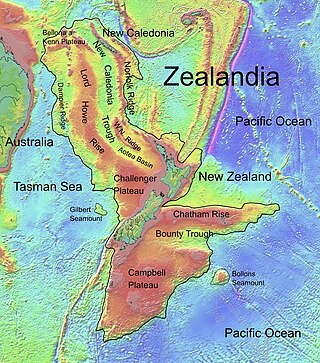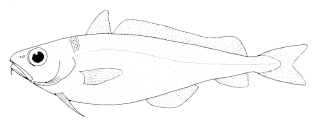
The Tasman Sea is a marginal sea of the South Pacific Ocean, situated between Australia and New Zealand. It measures about 2,000 km (1,200 mi) across and about 2,800 km (1,700 mi) from north to south. The sea was named after the Dutch explorer Abel Janszoon Tasman, who in 1642 was the first known person to cross it. British explorer Lieutenant James Cook later extensively navigated the Tasman Sea in the 1770s during his three voyages of exploration.

Lord Howe Island is an irregularly crescent-shaped volcanic remnant in the Tasman Sea between Australia and New Zealand, part of the Australian state of New South Wales. It lies 600 km (320 nmi) directly east of mainland Port Macquarie, 780 km (420 nmi) northeast of Sydney, and about 900 km (490 nmi) southwest of Norfolk Island. It is about 10 km (6.2 mi) long and between 0.3 and 2.0 km wide with an area of 14.55 km2, though just 3.98 km2 of that comprise the low-lying developed part of the island.

Ball's Pyramid is an uninhabited islet in the Pacific Ocean located 20 kilometres (12 mi) southeast of Lord Howe Island. The steep rocky basalt outcrop is the eroded plug of a shield volcano and caldera that formed 6.4 million years ago. It is 572 metres (1,877 ft) high, while measuring 1,100 metres (3,609 ft) in length and only 300 metres (984 ft) across, making it the tallest volcanic stack in the world.

The Lord Howe Rise is a deep sea plateau which extends from south west of New Caledonia to the Challenger Plateau, west of New Zealand in the south west of the Pacific Ocean. To its west is the Tasman Basin and to the east is the New Caledonia Basin. Lord Howe Rise has a total area of about 1,500,000 km2 (580,000 sq mi), and generally lies about 750 to 1,200 metres under water. It is part of Zealandia, a much larger continent that is now mostly submerged, and so is composed of continental crust. Some have included the 3,500 m (11,500 ft) deep New Caledonia Basin as within the rise, given its continental crust origin, and this would give a larger total area of 1,950,000 km2 (750,000 sq mi).

The notchheaded marblefish is a species of marine ray finned fish, one of the marblefishes belonging to the family Aplodactylidae. It is found in the southwestern Pacific Ocean.

The squashed face rattail is a rattail of the genus Nezumia, found around New South Wales, Australia, and New Zealand, at depths of between 1,250 and 1,300 m. Its length is about 35 cm.

Mora moro, the common mora, is a deep-sea fish, the only species in the genus Mora. It is found worldwide in temperate seas, at depths of between 300 and 2,500 m. Its length is up to about 80 cm. Other names in English include goodly-eyed cod, googly-eyed cod, and ribaldo.

Helicolenus percoides, the reef ocean perch, coral cod, coral perch, Jock Stewart, kuriarki, ocean perch, red gurnard perch, red gurnard scorpionfish, red ocean perch, red perch, red rock perch, scarpee or sea perch, is a species of marine ray-finned fish belonging to the subfamily Sebastinae, part of the family Scorpaenidae. It is found in the southwestern Pacific Ocean.
The Tasman starling was described in 1836 by John Gould as a species which occurred on both Norfolk Island and Lord Howe Island. In 1928 Australian ornithologist Gregory Mathews recognized that the plumage of the race from Lord Howe Island was much browner and more greyish than the plumage of the Norfolk Island race and split the species into two forms, the Norfolk starling, and the Lord Howe starling. Both subspecies are now extinct, thus so the species.
The Lord Howe Seamount Chain formed during the Miocene. It features many coral-capped guyots and is one of the two parallel seamount chains alongside the east coast of Australia; the Lord Howe and Tasmantid seamount chains both run north-south through parts of the Coral Sea and Tasman Sea. These chains have longitudes of approximately 159°E and 156°E respectively.

The Lord Howe parakeet, also known as the Lord Howe red-fronted parakeet, is an extinct parrot endemic to Lord Howe Island in the Tasman Sea, part of New South Wales, Australia. It was described as full species by Tommaso Salvadori in 1891, but subsequently it has been regarded as subspecies of the red-crowned parakeet. In 2012, the IOC World Bird List recognised it as species.

The East Tasman Plateau is a submerged microcontinent south east of Tasmania. Its area is 50,000 square kilometres (19,000 sq mi), and it is mostly from 2,500 to 3,000 metres deep. It is a circular piece of continental rocks surrounded by oceanic crust. Volcanism occurred there 36 million years ago. The East Tasman Plateau is separated from the island of Tasmania by 100 kilometres (62 mi) of deeper water, and the East Tasman Saddle is a higher ridge connecting the plateau to the Freycinet Peninsula region of the Tasmanian East Coast. This ridge runs north west from the plateau. South-west of the plateau is the L'Atalante Depression. The East Tasman Plateau represents a continental fragment.

Parin's spinyfin, Parin's spinyfish, black discfish, black spinyfin, or spiny discfish is a spinyfin of the monotypic genus Diretmichthys. Adults are found in oceans at depths of between 500 m to 2100 m. Its length is up to 40 cm.
Psychrolutes microporos is a species of deepwater marine fish in the family Psychrolutidae, commonly known as a blobfish or fathead. It is found in the abyssal zone in waters around Australia and New Zealand. A photograph of an individual taken in 2003 has become famous on the internet.
The Tasman Front is a relatively warm water east-flowing surface current and thermal boundary that separates the Coral Sea to the north and the Tasman Sea to the south.

Neolithodes bronwynae, commonly known as the rock crab, is a species of king crab which is found at the Whakatane Seamount in the Bay of Plenty, the Lord Howe Rise near Lord Howe Island, and possibly New Caledonia. It lives at a depth of 1,515–1,920 metres (4,970–6,299 ft). It has long spines and a deep-red colour.

Macrophthalmus pacificus is a species of sentinel crab found widely across the Indo-West Pacific Ocean, including India, Japan, Malaysia, New Guinea, Solomon Islands, and northern Australia.

The Three Kings Ridge, sometimes known as Three Kings Rise and more rarely at its southern end as the Three Kings Bank is a deep sea westward facing volcanic arc of Zealandia continental crust extending from 55 kilometres (34 mi) northwest of Cape Reinga / Te Rerenga Wairua, New Zealand on a line bisecting New Caledonia and Fiji in the South Pacific Ocean. Its southern portion contains the Manawatāwhi / Three Kings Islands which have biological significance as they are host to unique species and important marine ecosystems.

Dr Michael Robert Blair Gray was an arachnologist who specialised in the taxonomy of spiders at the Australian Museum in Sydney with a particular interest in the systematics of Australian funnel-web spiders (Atracidae).

Myopiarolis norfanz is a species of isopoda crustacean in the family Serolidae and was first described by Niel L. Bruce in 2009. It was named in honour of the NORFANZ Expedition.













